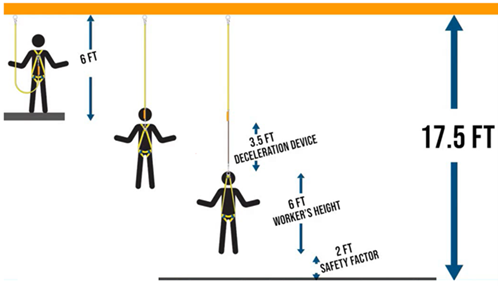Weekly Safety Training Topic No. 2430
Fall distance
A personal fall arrest system (PFAS)is a system used to safely stop (arrest) a worker who is falling from a working level. And often it’s recommended to know the A, B, Cs of Personal Fall Arrest Systems Anchorages - Body harness - Components (connectors like snap-hooks or Dee-rings, connection points, lanyards, deceleration devices, lifelines, etc.).
But don’t forget to add the D to the ABC’s of your Personal Fall Arrest Systems. The D is the distance you can fall depending on how your PFAS is rigged.
Total fall clearance distance for PFAS is the minimum vertical distance between the worker and the lower level that is necessary to ensure the worker does not contact a lower level during a fall. This should be calculated before a decision is made to use a PFAS.
The following variables are necessary to calculate the total fall clearance distance:
Free fall distance: Distance the worker falls before the PFAS begins to slow the fall. Free fall distance varies depending on the lanyard's length and where the anchor is set relative to the back D-ring on the harness. The maximum free fall with a PFAS allowed by OSHA is 6 feet.
Deceleration distance: 3.5 feet the maximum per OSHA requirements.
D-ring shift: 1 foot.
D-ring height (shoe sole to point between shoulder blades): Typically, about 5 feet.
Safety factor: Typically, 2 feet.
The total fall clearance distance is calculated by adding these values together.
The total fall clearance distance you will need varies with anchor point location and components. A six-foot lanyard for example will commonly require a total clearance of about 17 ½ feet.

If the available total fall clearance distance is not adequate, then another form of fall protection should be used, a fall restraint system, guardrail, or safety net.
Fall restraint systems
A typical fall restraint system is the same as a fall arrest system, except fall restraint allows the worker to work near a fall hazard without going over the edge. In most situations Fall Restraint should be the goal vs. Fall Arrest. The system, if properly used, tethers a worker in a manner that will not allow a fall of any distance. This system is comprised of a body harness, an anchorage, connectors, and other necessary equipment. Other components typically include a lanyard, a lifeline, and other devices. For a restraint system to work, the anchorage must be strong enough to prevent the worker from moving past the point where the system is fully extended and eliminating the fall to another level hazard.
The Builders offers fall protection courses and is available to assist if you have further questions.
Additional resource
Occupational Safety and Health Administration (OSHA) | www.osha.gov/fall-protection
 Download and print this Weekly Safety Training Topic with sign-in sheet. For the Spanish version, click here.
Download and print this Weekly Safety Training Topic with sign-in sheet. For the Spanish version, click here.
The information and recommendations contained in this “Weekly safety training topic” have been compiled from various sources believed to be reliable and represent the best current opinion on the subject. The Builders, a chapter of the AGC, in no way guarantees, insures or warrants the absolute correctness or sufficiency of any information contained within. The Builders expressly disclaims all liability and assumes no responsibility therewith. For more information, please call 816.595.4158.